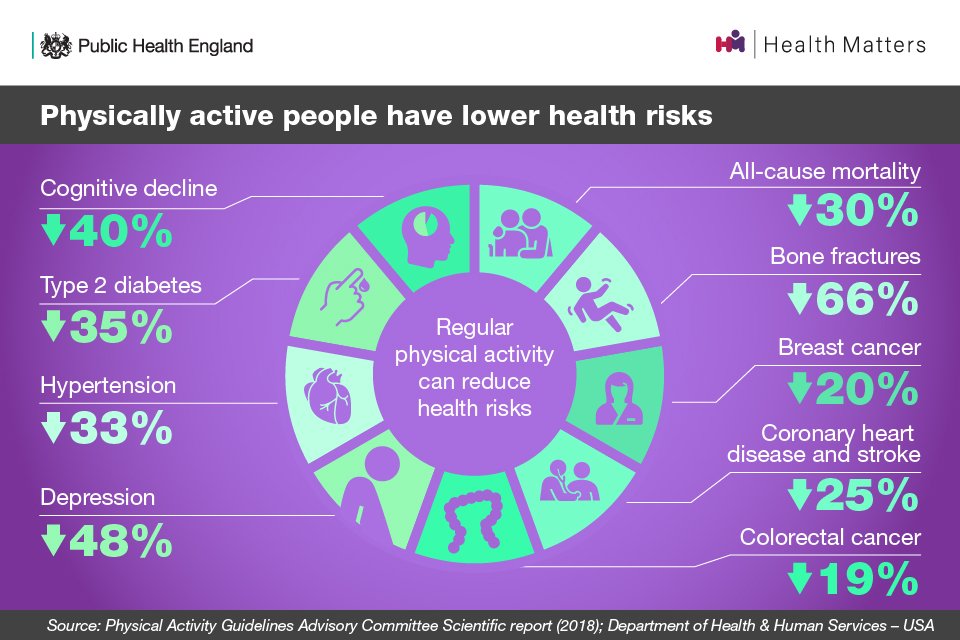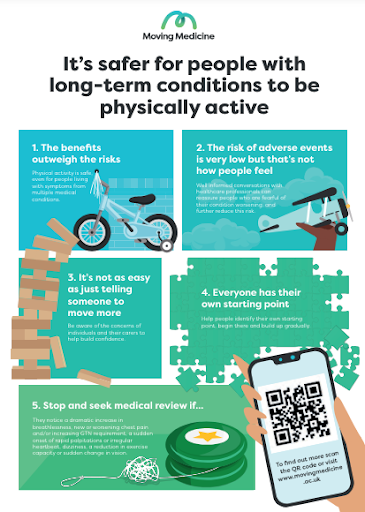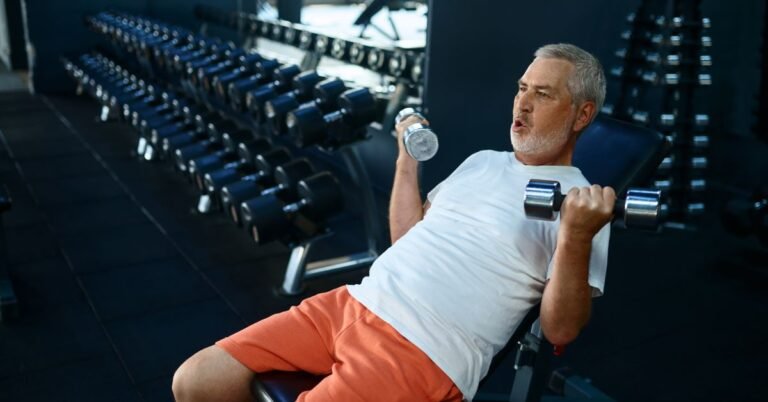One in three adults in England are currently living with at least one long term health condition; this includes conditions such as type two diabetes, hypertension, osteoarthritis, cardiovascular diseases, obesity and cancer.
People are twice as likely to be inactive if they have a long term health condition.
There are many barriers that can make it harder to be active. Some worry whether activity or exercise is safe for them. Some don’t know what type of exercise they should be doing. Some haven’t done any exercise for many years and lack motivation, as well as the support needed to get started.
If this is you or someone you know, we’ve put together this article to encourage you or someone you care about to get moving. It might be one of the most effective things you can do to reduce the risk of, or treat a long term condition.
What we’ll cover:
Why you should exercise with a long term health condition
Physical activity is not only associated with a reduced risk of many long term conditions, but it is also one of the primary treatment strategies for almost all of them.
Evidence shows that exercise can prevent and help to manage conditions including:
- Diabetes
- Some types of cancer
- Cardiovascular disease
- Hypertension
- Osteoarthritis
- Back pain
- Mental health conditions
- Dementia
- Chronic pulmonary disease
- Asthma
This diagram shows the degree to which exercise can reduce the risk of different conditions:

Is it safe?
A large research review and expert clinical consensus statement published in the British Journal of Sports Medicine in 2022 concluded that physical activity is safe, even for people living with multiple long term conditions, and the benefits far outweigh the risks.1
Another more recent review of systemic reviews (one of the highest levels of evidence) evaluated the results from 990 randomised controlled trials. It concluded that exercise has a positive benefit in the majority of long term health conditions.2
These studies emphasise the importance of reassurance, support and education on the benefits of exercising with a long term health condition and dispelling the myths around it.
They also acknowledge that everybody is unique and should have individualised starting points, depending on a person’s current activity level and building up slowly.
Recommended reading: The Ultimate Guide to Strength Training For Older Adults
While it’s been shown to be safe and highly recommended, there are some possible short term side effects that are important to be aware of:
Short term pain
You might experience a short term increase in pain when starting a new physical activity. But as the body adapts, this should improve. In the long term, physical activity helps to improve pain and function.
Fatigue
A temporary increase in fatigue is normal after a new activity, as the body is adapting. This is especially the case if your physical active are generally low to start with.
However, being inactive is actually associated with higher levels of fatigue. It sounds contradictory but being more active leads to reduced fatigue over time and improved sleep.
Shortness of breath
Shortness of breath is normal with increasing activity levels. It’s the normal response of increased oxygen demands of your muscles, and your heart and lungs responding to this.
Often people with heart and lung conditions such as chronic pulmonary disease, asthma, and heart failure can be very worried about this shortness of breath. However, there are very few reported contraindications or adverse events in these populations.
In the long term, physical activity is associated with improved outcomes and fewer adverse events for those with heart and lung conditions.
One tip is to use the talk test – which means you may be breathing a bit faster but you can still talk (but perhaps not sing!).
Chest pain and palpitations
There are contraindications to physical activity until appropriate medical management is sorted including recent cardiac events, unstable angina, unstable dysrhythmias etc.
If you are experiencing new, severe and worsening chest pain, or a sudden onset or unusual change in heart rate, exercise would not be advised. However if you have a stable heart condition, the risk of cardiac events reduces as physical activity and fitness is gradually increased.
Dysglycaemia
Dysglycaemia (altered blood glucose) is a short term normal response to exercise. The benefits of exercise outweigh the risks in people with both type 1 and type 2 diabetes.
People with type 1 diabetes may need to monitor their blood glucose responses to exercise and plan or modify their insulin around this response.
There are very few contraindications to exercise for people with type 2 diabetes. A systemic review found no significant adverse events for people engaged in physical activity.
Falls
Risk of falls is often a worry in the older, frailer population. However exercises focused on strength and balance can significantly reduce the risk of falls, injuries and hospital admissions in this group.
The infographic below from Moving Medicine summarises the expert clinical consensus.

You can view the full infographic as a PDF here: Download PDF
How to get started
Starting physical activity can seem scary at first. But we want to show you that it doesn’t need to be!
It doesn’t need to be in a gym, highly intense or require special equipment if you don’t want it to. Physical activity can be anything that gets you moving. If you can turn it into something that you enjoy, that’s even better as it will help to keep you motivated.
It might be something simple such as increasing your daily steps, adding more brisk walks in, doing home workouts, dancing, community classes, swimming, a new sport, or it could be a session in the gym.
While the public health guidelines of 150 minutes of moderate intensity exercise per week can seem HUGE when you aren’t currently very active – any activity adds up. Start small, and build up gradually.
Write down your own motivation to be more active. Perhaps you want to manage your symptoms better, or you want to return to any activity you used to be able to do. Or maybe you want to be able to go out with your family, or remain independent into old age.
If you haven’t been active for a while, make a list of activities you have enjoyed in the past:
- Do you prefer activity in a group or alone?
- Do you prefer activity indoors or outdoors?
- Do you like organised activities or something you can do independently?
- Do you need support from friends, family or local community groups?
Online resources to help you start
There are plenty of resources available online to help you, including the many free articles and programmes on our website. We also recommend:
We Are Undefeatable
https://weareundefeatable.co.uk
We Are Undefeatable is a campaign created by 15 leading health and social care charities with the aim to promote activity for people with a range of long term health conditions.
Active 10
https://www.nhs.uk/oneyou/for-your-body/move-more/active-10
The Active 10 App is a free NHS app to promote and track brisk walking.
Go4Life (Youtube)
Go4Life Exercise Youtube Video playlist has a number of short videos of exercises for older people.
Watch the first video below and click ‘Watch on Youtube’ to see the full playlist:
NHS Strength Exercises
https://www.nhs.uk/live-well/exercise/strength-exercises
The NHS website is a great place to start if you are looking for basic exercises to get started on, exercise tips and some fitness guides, ranging from 10 minute workouts to the NHS’s Strength and Flex weekly exercise guide.
Couch to 5k
https://www.nhs.uk/live-well/exercise/get-running-with-couch-to-5k
The Couchto5k App is a free NHS app with a running programme which gradually builds you up to being able to run 5k within 9 weeks.
We also recommend reading our guide to running for older adults.
Couch to Fitness
The Couch to Fitness website has a number of free nine week fitness plans, with three sessions per week, adapted for beginner, intermediate and advanced, suitable for a range of fitness levels.
Keeping Strong
And of course you can try our very own free strength training programmes:
There are so many positives to increasing your activity levels whatever your age, so what are you waiting for? Get started today!
References
- Reid, H. et al. (2021) ‘Benefits outweigh the risks: a consensus statement on the risks of physical activity for people living with long-term conditions’, British Journal of Sports Medicine, 56(8), p. bjsports-2021-104281. Available at: https://doi.org/10.1136/bjsports-2021-104281.
- Dibben, G.O. et al. (2024) ‘Evidence for exercise-based interventions across 45 different long-term conditions: an overview of systematic reviews’, eClinicalMedicine, p. 102599. Available at: https://doi.org/10.1016/j.eclinm.2024.102599.




